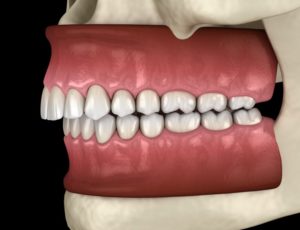
Malocclusion, also known as bite misalignment, is an orthodontic issue that’s estimated to impact over half of the global population. So, if you’re also affected by it, know that you’re not alone! In fact, there are several different types of treatments that you can choose from to address it and minimize your risk of developing secondary dental conditions. Overbite in particular is incredibly common, estimated to impact around 22 percent of people. Read on to learn more about whether it’s worth it to fix, and how you could go about doing that.
What is Overbite?
An overbite, which often leads to “buck teeth,” is when the upper arch of teeth stick out beyond the lower front teeth. It’s a type of malocclusion, or bite misalignment, that can be caused by a variety of habits and conditions, including:
- Genetics: Overbite runs in your family.
- Thumb & Pacifier-Sucking: You sucked on your thumb or pacifier past the age of three, causing your teeth and jaw to develop and result in malocclusion.
- Teeth Grinding: Also known as bruxism, teeth grinding can lead to jaw dysfunction and misalignment.
- Tooth Loss: When missing teeth don’t get replaced, the existing teeth can shift to fill in the gaps in your smile, resulting in overbite formation.
- Tongue Thrusting: If you thrust your tongue or did as a child, it could result in maxillary protrusion.
- TMJ Dysfunction: TMJD causes a variety of symptoms that could lead to malocclusion, like bruxism.
How Can You Treat Overbite?
There are two main treatments that you can choose from, depending on the severity of your overbite, to address the misalignment:
- Traditional Braces: Using metal brackets attached to each of your teeth as well as an archwire, your dentist can gently and strategically shift your teeth into their ideal alignment. In cases where bite problems are a concern, like overbite, you may also need to wear elastics to shift the jaw.
- Invisalign: Invisalign can be used to address less severe cases of malocclusion. They utilize clear, plastic trays to place a gentle amount of pressure onto the teeth to shift them. Due to their discreet appearance and removable convenience, many adults opt for this orthodontic treatment method over traditional braces so they can maintain their professional appearance.
Why Should You Receive Treatment for an Overbite?
When left untreated, overbite can result in a variety of secondary dental health concerns that could reduce the lifespan of your smile. When misalignment persists, it can lead to enamel erosion, TMJ disorder and the chronic discomfort that often comes along with it, and even speech problems. Although orthodontic treatment may take awhile to complete, countless patients who underwent Invisalign or braces to address their malocclusion will agree that it’s well worth it!
About the Author
Dr. Rafiq Hirji has well over a decade of experience as a dentist. He has also completed several specialized training courses, including advanced education in orthodontics that allow him to offer both traditional braces and Invisalign in-office. With a comprehensive menu of services offered, you’ll be able to stick with the same, trusted team, no matter your dental concerns. For questions or to schedule a consultation, visit Daily Smiles MacArthur Dental and Orthodontics’ website or call 972-546-4114.
